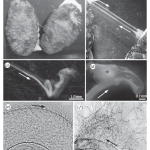![]()
New research by Bornemann et al. in Science this week indicates that warming periods might actually promote ice growth. Using forams from core samples taken on the deep ocean floor off South America, the researchers reconstructed temperature records for the Turonian (93.5 to 89.3 millions years ago). Despite a relatively balmy 35 degrees C tropical sea surface temperature, the glaciation events took place (evidenced by the a positive d18 O excursion in the marine limestone). Absolutely love this quote from the article (emphasis mine)
We are left with the apparent paradox that the prevailing extraordinarily high tropical temperatures during the Turonian were not a barrier to the initiation and growth of large continental ice sheets. The development of these ice sheets could be attributed to an increase in the activity of the hydrological cycle, which must have initiated more humid conditions and enhanced precipitation in the high latitudes.
Andre Bornemann, Richard D. Norris, Oliver Friedrich, Britta Beckmann, Stefan Schouten, Jaap S. Sinninghe Damste, Jennifer Vogel, Peter Hofmann, and Thomas Wagner (2008) Isotopic Evidence for Glaciation During the Cretaceous Supergreenhouse. Science, 319:189-192.
DOI: 10.1126/science.1148777






Well, it wouldn’t be the first time that something that was completely counter intuitive turned out to be correct upon further investigation. I have found the old, Wonders never cease, to be a truism in life.
Dave Briggs :~)
Forgive a probably obvious question from a non-scientist. O18 levels indicate water is being locked away from the ocean. But why is it assumed to be in ice sheets? I picture an earth with 35C surface ocean temps to have much greater precipitation, presumably putting lots of additional water in the atmosphere and especially in the ground. O18 levels increasing, as I understand it, indicates a net decrease in ocean water due to evaporated water not returning to the ocean. But saturating a greater portion of the landmass which may have been arid would have the same impact as glaciation, no? I have no doubt I am missing something, so again apologies if this is obvious and stupid.
Jason,
Excellent question! Perhaps the ambiguity above is the result of me leaving out a key method in the paper.
As you no doubt already know, The ratio of O18 and O16 in forams (and other organisms with a calcium carbonate skeleton) can determine the seasurface temperature (SST). When temps are cool, seawater with the lighter O16 evaporates at a slightly faster rate. Thus snow and rain are O16 rich and seawater is O18 rich.
Now what if you could compare this to a salinity independent measure of temperature in addition to the oxygen isotopic ratios. From the paper, “the tetraether index of lipids with 86 carbons atoms (TEX86), which is based on the distribution of crenarchaeol membrane lipids. Because the growth of continental ices enriches seawater in O18, the delta O18 chemistry, when constrained by TEX86 temperature estimates, can be further used to estimate the size of continental ice sheets.” To explain the genius TEX86 method a little more…Relatively recently (2004), it was found that lipids in the membranes of a marine Archaea changed with temperature in order to regulate membrane fluidity. Thus measurement of the composition of them can indicate temperature at the time.
Sure, enhanced precipitation like snow for some warming makes sense – but is that going to make up for net melting of existing ice coverings? After all, sea level is getting higher as a known fact, and that’s the actual given we have to deal with (not to mention other things.)
Thus snow and rain are O16 rich and seawater is O18 rich.
Ok, I’m going to be a total stable isotope snob right now. Stable isotopes are a relative measure of the less abundant isotope to the more abundant isotope (i.e. O18/O16) compared to an arbitrary universal standard. Though what said was certainly not wrong, it is more *technically* correct, to state that snow and rain are more depleted in O18 relative to O16 than seawater.
Ok that was total dorkiness, but I work with this stuff for my dissertation.
Snob!